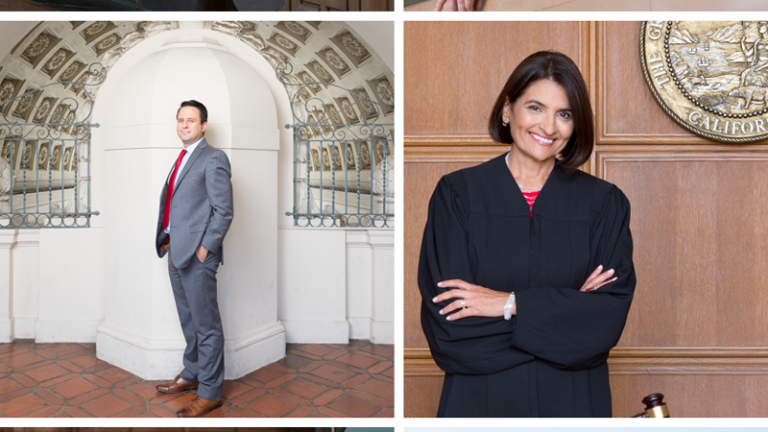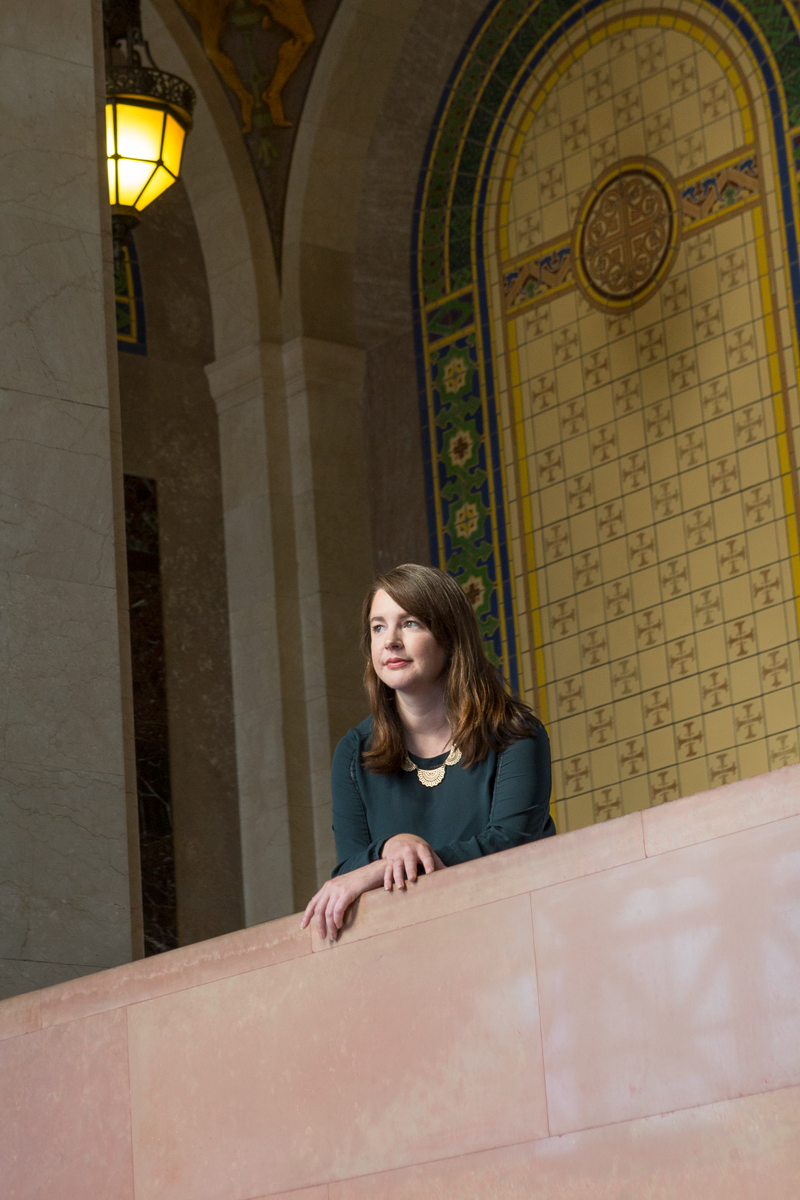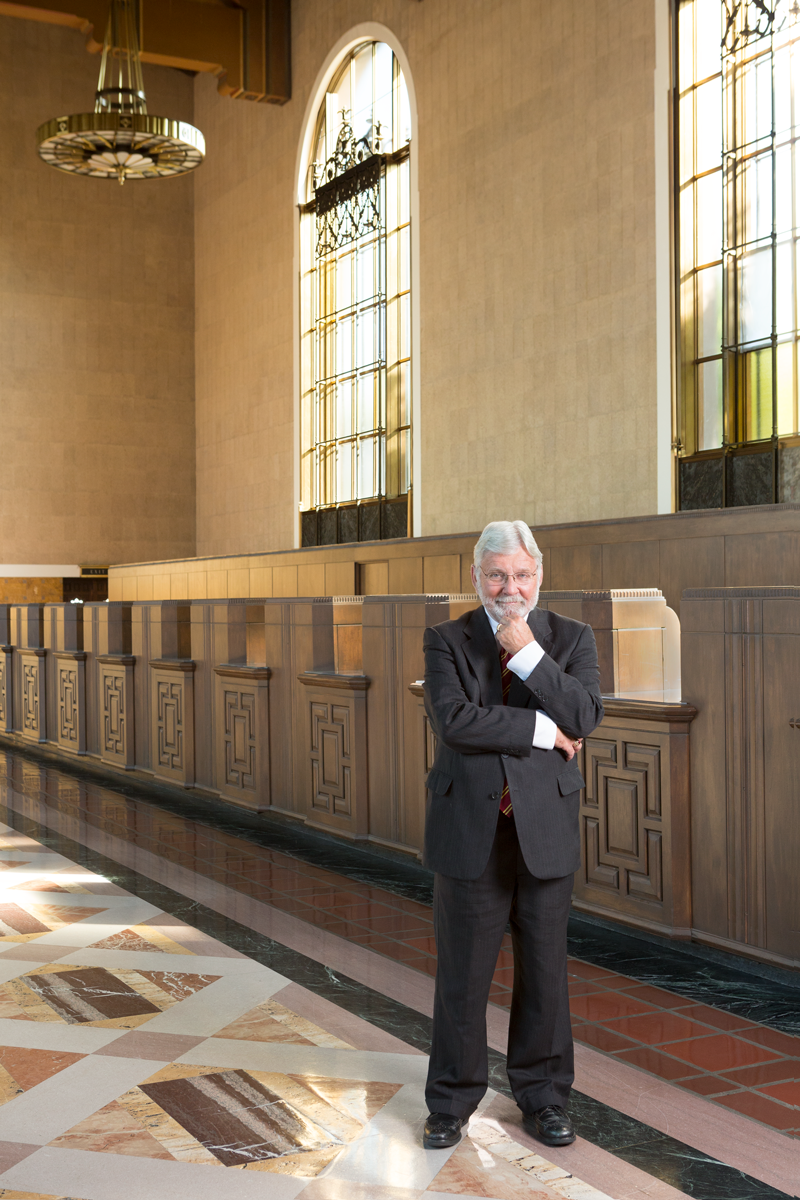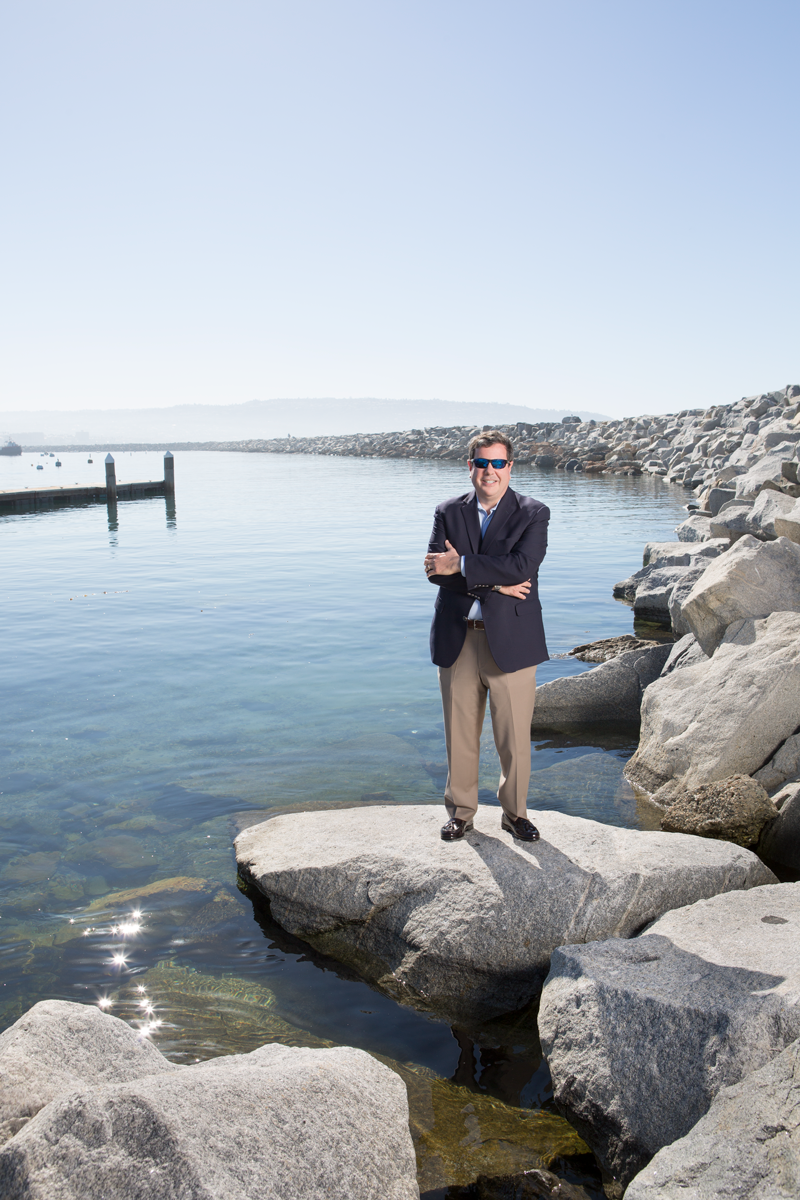
Trojans Dedicated to Public Service Work to Improve Life in Los Angeles
USC alumni are woven throughout the fabric of Southern California civic life.
PHOTOS BY NOAH WEBB
Growing up in the Highland Park community of Los Angeles in the 1950s, Art Leahy MPA ’82 recalls only one tall building around, about 40 blocks away from his house: City Hall. Today, of course, skyscrapers pepper L.A.’s downtown. Leahy has seen a lot change over the last 60 years, especially from where he sits as CEO of Metrolink, Southern California’s regional rail system.
A transit guru for 45 years, Leahy has shepherded railway, bus and freeway projects in the L.A. area during the last half-century of explosive public transportation growth. Just as transit has grown, so have major challenges in housing, the environment, the economy, the justice system and—seemingly everyone’s gripe — traffic.
These are problems that Leahy faces every day, but he’s not alone in trying to do something about them. Across the region, one of the world’s largest metropolises, Trojans are working to improve life. Threaded throughout the fabric of the government, a legion of USC alumni — especially those from the USC Price School of Public Policy — tackle some of society’s thorniest issues, from housing affordability to health care, from sustainability to social justice.
It seems fitting that the same building Leahy used to gaze at as a kid is where USC Price got its humble start 89 years ago: City Hall.
LAYING THE GROUNDWORK
In 1929, the founding scholars of what was then the USC School of Citizenship and Public Administration studied ways the city could operate more efficiently and also raise government and civic engagement within the community.
Today, about 16,000 USC Price alumni across the globe work to strengthen democratic governance, urban development and social and health policy
The mission to boost the quality of life for people and their communities, here and abroad, continues today at USC Price.
“We’re a professional school interested in making a difference in society,” says Jack Knott, dean of USC Price, “and that’s what we’ve been about since the beginning.”
Today, about 16,000 USC Price alumni across the globe work to strengthen democratic governance, urban development and social and health policy—the interdisciplinary themes of the school’s academic programs and its 13 research centers and institutes.
Well-known local alumni include former U.S. Secretary of Labor Hilda Solis MPA ’81, now an L.A. County supervisor, and two prominent members of law enforcement: L.A. County Sheriff Jim McDonnell MPA ’89 and Bernard Melekian DPA ’12, former police chief of Pasadena and former director of the Office of Community Oriented Policing Services in the U.S. Department of Justice.
Look at communities around the county, though, and you’re likely to find USC Price alumni operating behind the scenes at different levels of government and public service. According to Knott, the single largest group of city managers in the region are graduates of USC Price.
The school now has about 1,850 students, about 30 percent more than it had when Knott became dean in 2005. In 2016, U.S. News & World Report ranked the school No. 4 in the nation among graduate schools for public affairs.
One engine behind USC Price’s growth has been the nearly $135 million the school has raised in the last five years. Some of these funds have been used to support investment in the development of new degree programs and the hiring of new faculty.
The gifts also have helped raise the profile of the school, thus attracting more applicants. And a portion of the gifts has gone to scholarships, which have helped attract a more diverse student body.
In short, the money has, indirectly, readied a healthy pipeline of talented civic leaders.
Here are just a few who are making a difference across the county.

Angelenos live in a city that’s one of the world’s most notorious seismic hotspots. For city planners, thinking (maybe even obsessing) about an earthquake’s potentially devastating impact is imperative to save lives.
Just ask Ashley Atkinson MPA ’07, MPL ’07. Until recently, she had no clue what terms like “soft-story building” and “non-ductile concrete” meant.
Atkinson, a planning specialist in L.A. Mayor Eric Garcetti’s Office of Economic Development, now tosses these and other terms around with casual confidence, the result of her working on a seismic retrofit ordinance that went into effect nearly a year ago.
“Ultimately, this ordinance will result in a much safer and more resilient L.A.,” says Atkinson. An East Coast transplant, she moved to L.A. in 2004 and didn’t expect to stay after graduate school. But when she discovered L.A.’s compelling array of planning and development challenges she could work on, she stayed, and even bought a home.
The seismic retrofit ordinance affects some 14,000 buildings throughout the city, most of them residential, which will be upgraded structurally over the next two decades.
Atkinson also helped Garcetti establish a goal of permitting 100,000 new housing units through 2021 to address L.A.’s chronic housing shortage, one of the culprits that has made the area the least affordable place in the country to buy a home, according to an August 2015 study.
Of these 100,000 new units, 15,000 will be set aside as affordable housing, Atkinson says.
With nearly 4 million people in the city, or more than 1.3 million households, making a difference can feel overwhelming, but the key is to look at the big picture.
“As a generalist, I have to draw on bits and pieces of real estate, policy and public administration,” Atkinson says. “We look at what is realistic, what we can accomplish, and how we can make sure the resources are there to make these goals a reality.”
Being realistic is an attitude echoed by many of her fellow USC Price alumni. They seem to adopt it as a mantra, a lesson learned in their real-world-focused classrooms.
“I never felt like what I was learning was just theoretical, philosophical gobbledygook,” transit guru Leahy says. “What I learned in the classroom was directly applicable to how a large operation is managed, from budgeting to administration and operations analysis.”

Before Leahy became CEO of Metrolink in 2015, he ran the Los Angeles County Metropolitan Transportation Authority (Metro) for six years and, before that, the agency’s counterpart in Orange County. Under his watch, the 22 and 5 freeways were widened and the 91 Freeway toll lanes were purchased and converted into a profitable publicly managed system.
Leahy recalls that in 1990, L.A. didn’t have a single inch of rail in operation. Now, L.A.’s Metro is about to pass San Francisco’s BART for ridership on its rail lines, Leahy says. Metro’s Blue Line, which connects Long Beach to downtown L.A., was established when he was chief operating officer, and the Red Line, which connects North Hollywood to downtown L.A., launched in 1993 when he was CEO.
“You can do things today that would have been inconceivable 26 years ago,” Leahy says proudly. Today, L.A.’s Metro trains average about 9.5 million boardings per month.
URBAN UPLIFT
Giving Angelenos options to get from point A to point B is a big step in improving livability, but for Nat Gale MPL ’11, MPA ’11, transportation goes hand in hand with investing in neighborhoods themselves. Gale is a key member of the Great Streets Initiative, a community development program housed in Garcetti’s Office of Transportation. The initiative aims to improve sections of 15 L.A. streets by encouraging local businesses to develop investments that make the corridors more pedestrian-friendly and safe. Recent projects have included everything from street festivals to painting murals along Western Avenue.
Meanwhile, in Long Beach, Mayor Robert Garcia MA ’05 (a graduate of the USC Annenberg School for Communication and Journalism) has garnered attention for improving sidewalks, crosswalks, beach paths and traffic signals and adding bike lanes and more public transportation routes to make it easier to get around town. The improvements have earned national interest and Long Beach was recently named one of the 10 Most Walkable Cities in the U.S. by real estate website Redfin.
Scott Ochoa MPA ’06, Glendale’s city manager, has focused on a “smart growth” approach to revitalize his city’s downtown with a balanced mix of office, retail and residential projects.
A city manager for more than a dozen years, Ochoa—who first got a taste of city management while serving as an intern for the city of Monrovia while studying at USC—envisions an “18-hour business day” where workers, residents and visitors linger in the evening to shop, eat and enjoy downtown Glendale’s growing list of businesses.
Ochoa, whose office employs four USC Price students and alumni, says the city’s diverse investments in infrastructure, parks and economic development yield major benefits, from advancing sustainability goals to improving quality of life to attracting new tenants to town.
“We’ve come a long way in performance management and how we achieve measureable results to make a positive difference for our residents and businesses,” Ochoa says.
COURTING CHANGE
Growing up near USC’s University Park Campus, Dalila Corral Lyons ’81 thought that attending the university was a distant dream. The first in her family to attend college, she had a passion for social justice, but didn’t discover her career path until her time at USC Price.

Now a judge for the Superior Court of L.A. County, she rules on civil cases that range from employment matters to business and contract disputes. As a voting member of the Judicial Council of California, Corral Lyons makes policy decisions that affect all 58 county courts in California.
The council has approved funding to courts to modernize how traffic tickets are paid and how people report to jury duty, eliminating the need for many to have to drive to court.
“It’s very rewarding to make decisions that will positively impact the judicial system and hopefully make it more efficient and responsive to court users,” Corral Lyons says.
Her work isn’t easy, and she knows people have many gripes about the judicial system.
“It’s gratifying to be in a position to solve some of those complaints and improve the administration of justice,” Corral Lyons says. “Unfortunately, we are dealing with significant budget reductions. But despite the severe budget cuts, we do our best to ensure an impartial and accessible administration of justice.”
Seeking justice has long been a passion for Miguel Espinoza MPP ’07, JD ’07, who as a prosecutor for the Los Angeles County District Attorney’s Office works with victims of the worst crimes imaginable: rape, child molestation, domestic violence, human trafficking, homicide.

To say public service is in Espinoza’s blood is an understatement.
His grandmother was a bilingual public school teacher, his mother is a public school teacher, his father was a deputy public defender and judge, his grandfather was a Spanish-language court interpreter, his brother is a deputy county counsel and his sister is currently studying at USC to be a social worker.
Oh, and Espinoza’s wife is a deputy city attorney in L.A.
“I decided to leverage my law degree to seek justice for the people living and working in Los Angeles County,” says Espinoza, a former political strategist. “Working as a special victims prosecutor has allowed me to do this on a daily basis.
“I never wonder why I wake up every day and go to work. This job is totally fulfilling. When I walk into work each morning, I know exactly why I’m there: to fight for safer and healthier communities.”
USC Price, Espinoza says, expanded his policy and analytical skills beyond his law degree.
“It emphasized group work and people thinking collectively about ways to move communities forward,” Espinoza says. Such an approach is needed, he says, to reform the overtaxed criminal justice system, whose complex challenges include overcrowding and a high recidivism rate among offenders.
A CLEANER CITY
As Southern California heads into its sixth year of crippling drought, tapping into a sustainable water supply strategy is no longer a choice. Enter Thomas Wong MPA ’13, who doesn’t mind shaking up Division 3 of the San Gabriel Valley Municipal Water District.
“As a young person, I saw a lot of long-term issues that weren’t being discussed,” says Wong, who was 25 when he was elected to the board in 2012. Chief among the long-term issues was ensuring a clean and affordable water supply for the region and determining whether the cities in his district—Monterey Park, Alhambra, Azusa and Sierra Madre—were prioritizing water sustainability.

Wong believes the water district could and should be doing more to engage the community about water supply issues, and also ask bigger questions: “How do we build a stronger environmental ethic and robust community conversation around what our streets, our neighborhoods, our businesses will look like in 10, 20, 50 years? How do we build the future we want to live in?”
Environmental issues and sustainability have been a passion of Wong’s since he took a high school environmental science class. He served as a member and chair of the Monterey Park Environmental Commission and handled environmental and water issues while working for former California Assemblyman Mike Eng. He was named president of the board in late 2015 and has made community engagement one of his priorities, especially as California grapples with an ongoing drought.
For Wong, the issue is educating the public on collective action. “So it’s even more important that we engage them so that they know what issues are coming up, why we have to pay for these investments, and what these investments are going to do to make our communities more sustainable.”

Across the county in Hermosa Beach, Tom Bakaly MPA ’89 has focused on air quality. The city’s former city manager pushed efforts to clean the air and expanded the city’s 2011 smoking ban to downtown, the beach and all public spaces. In November, he joined the Beach Cities Health District, which supports health programs in Redondo Beach, Hermosa Beach and Manhattan Beach. The agency offers residents free community programs ranging from consultations to supporting seniors living independently at home to “walking school buses” to escort children to school safely on foot.
Prior to becoming city manager of Hermosa Beach, Bakaly was city manager of Park City, Utah at the relatively young age of 39.
“I don’t think that happens,” Bakaly says, “without having that practical application, that skill set, that I got from USC.”
